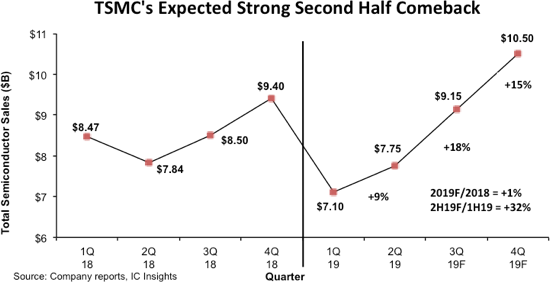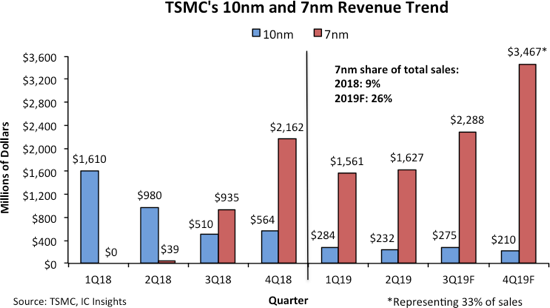Taiwan Semiconductor Manufacturing Company’s heavy investments in advanced wafer-fab technology are set to pay off significantly for the world’s largest silicon foundry as it continues the production ramp of 7nm ICs in the second half of this year, according to an analysis in IC Insights’ September Update to the 2019 McClean Report.
Figure 1 provides an updated outlook for TSMC’s 2019 sales using quarterly revenue reported by the foundry in first half of this year and IC Insights’ projection for the second half. As shown, the company has estimated its current full-year sales to be about flat with 2018, but its 2H19/1H19 sales are forecast to jump by 32%—more than three times the 10% growth rate expected for the entire IC industry in the second half of 2019, based on IC Insights’ projection. There is little doubt that 7nm application processors for new smartphones from Apple and Huawei are driving the forecast for a strong second-half rebound in TSMC’s sales.

Illustrating how dominant TSMC is in the leading-edge pure-play foundry market, the company is expected to have over 7x the dollar volume sales at <40nm processes as compared to the combined 2019 total of GlobalFoundries, UMC, and SMIC ($22.9 billion versus $3.2 billion). SMIC entered initial production of 28nm technology in 4Q15, more than three years after TSMC began fabricating wafers with its 28nm process. SMIC expects to log recognizable revenue from its new 14nm FinFET technology sometime in the fourth quarter of this year (and introduce 12nm FinFET technology in 2020), once again about three years behind TSMC’s introduction of similar processes.
In 2019, TSMC is expected to have 66% of its sales come from <40nm technology. Moreover, IC Insights is forecasting that TSMC will have $8.9 billion in 7nm revenue this year (Figure 2), representing about 26% of its total sales in 2019 and 33% of its 4Q19 revenue (thanks to customers Apple and Huawei)!

The pace at which TSMC’s customers adopt leading-edge process technologies has quickened, as well. It took eight quarters for the foundry’s 40-45nm technology to secure greater than 20% of its total sales, five quarters for its 28nm process to exceed that threshold, and only three quarters for its 7nm process to account for more than 20% of its quarterly revenue. In fact, TSMC’s 20nm, 14nm, and 10nm technologies all surpassed 20% of its total sales within three quarters. Amazingly, the company believes that its ramp of 5nm technology, as a percent of its sales, will be even faster than its 7nm process! Strong demand for the advanced nodes has resulted in tight supply and longer lead times. As a result, TSMC is already planning to set aside more funds to expand capacity for its advanced processes.


